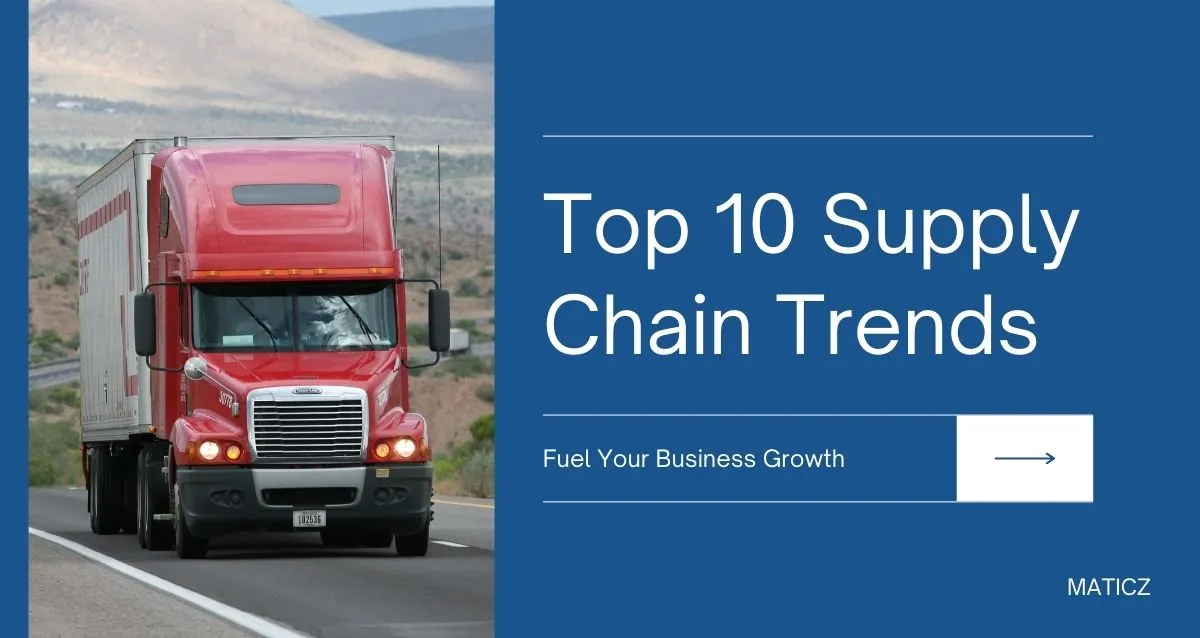Share Posts

Top 10 Supply Chain Trends in 2025
46
4696
103
With the help of innovations and technologies, Supply Chains have become drastically more popular in recent years. Because of this reason, there is a need for imaginative strategies to manage them more effectively and to create flexibility in supply chain operations. In this article, we are going to see the primary trends that shape supply chain management.
Top Supply Chain Trends
So now, Let’s take a look at the future trends in supply chain management.
1. AI and IoT
2. Cloud-Based Products
3. Blockchain
4. Supply Chain as a Service (SaaS)
5. Digital Supply Chain Twins
6. Post-Pandemic Resilience
7. Robots and Automation
8. 5G Networks
9. Circular Supply Chain
10. E-Commerce
Artificial Intelligence and Internet of Things
Currently, Artificial Intelligence and the Internet of Things are becoming increasingly popular in the Supply Chain Enterprise. AI-powered systems can be used to identify and address probable issues in the supply chain such as bottlenecks, delays, and disruptions from unexpected conditions. To enhance the accuracy and speed of inventory management and forecasting, this system can be utilized.
The usage of Robotic Process Automation (RPA) also plays an important role in the supply chain that allows the automation of repetitive tasks such as data entry, Document processing, and tracking the order, thereby eliminating manual labor and improving competence in the process of the supply chain. Also, these two massive technologies assist in balancing supply with the demand forecast and transform the way you observe future trends in supply chain management.
Cloud-Based Products
Cloud-based products can transform supply chains over the usage of data analytics, and mobile applications, and leverage social media. According to a study, The market for cloud-based supply chain management will cross more than $40 Billion by 2027. This assists companies and large-scale businesses in recognizing notable benefits from key marketplace trends that redefine traditional networks of supply chains.
Cloud-based Computing aids in improving responsiveness to many supply chain disruptions such as volatility, that has magnified itself in today’s supply chain. Also, it helps supply chains unlock the value of the data. These cloud-based solutions allow companies to exploit the widespread data (both internal and external) that is available all over the ecosystem, to create actionable insights, making their supply chain network sharp-witted.
Blockchain
Blockchain is one of the thriving technologies that offers outstanding visibility and transparency. The successful growth of blockchain is the key supply chain trend in 2023 as companies seek to improve security, transparency, and efficiency in their activities. These Blockchain technologies provide users with highly secure and unbreakable data and transactions, which makes it perfect to trace the activities of products or goods via the supply chain.
With the help of its high level of security, this blockchain can assist in eradicating fraudulent activities, improve the visibility of the supply chain, and increase the collaboration of participants. The combination of Blockchain and Supply Chain is driven by the necessity to address challenges like complex logistics, expanding globalization, and customer demand evolution.
Supply Chain as a Service
Supply Chain as a Service (SCaaS) is a new method to manage the challenging process of delivering goods from customers to manufacturers. It includes outsourcing the complete supply chain operations to the third-party provider.
This method permits businesses to focus on their core capabilities while experts optimize the process for speed and affordability.
These SCaaS provide various exciting opportunities to businesses and can be effectively used by many different enterprises. Especially, by upgrading SCaas, businesses can create cost-effective activities and increase the growth of the business or company frequently that uphold maintaining its competitiveness.
Digital Supply Chain Twins
Digital Supply Chain Twin technology has accepted various industries and businesses and become more accessible and feasible for users. Still, this twin technology rules the world of the supply chain. Digital twins permit a multitude of enabling technologies like cloud computing, sensors, AI, simulation, augmented and virtual reality, visualization, and more.,
These twin technologies monitor their physical environment via sensor networks that gather real-time data dynamically. They evolve and learn data and its contexts by interacting with humans, devices, and other networked digital twins. These abilities make this twin technology more active and socialized. Because they can communicate and collaborate with their associated physical and digital devices or objects, mainly with humans without any pause. Digital Supply Chain twins support end-to-end trackability and visibility, which permits the practitioners of the supply chain to spot patterns of highly complex and vibrant behavior.
Supply Chain Resiliency
During the pandemic period, many businesses are getting confused to deliver their product or services. At that time, it highlighted the importance of supply chain resiliency that satisfies the necessity of businesses to rethink their business strategies. This Supply Chain Resiliency indicates the capability of the businesses to recover from all disruptions to their supply chain.
The resilient Supply chain is characterized by various kinds such as visibility, collaboration, flexibility, and more., This resilient supply chain adapts to businesses and makes changes in demand, supply, and logistics, maintains sequence operations, and risk mitigation. Many businesses invest in developing supply chain resiliency can endure futuristic interruptions and gain a competitive edge in the post-pandemic world.
Robots and Automation
Supply Chain Management utilizes robotic process to automate low-value tasks, that simplifies operations and remove human error. The robotic automation process is used in supply chain management to automate low-value tasks, simplifying operations and eliminating human error. Robotics permit the supply chain to grow quicker and fulfill supply demand as it arises. Robotics also enable increased workforce flexibility, which boosts more security for workers by taking over riskier jobs such as collecting products from high storage spaces.
5G Networks
5G - the Fifth Generation of Wireless Technology. With its rapid speed, low latency, and increased accessibility of device features, it is set to transform digital connectivity. Apart from offering better network performance for consumers, 5G has an opportunity to transform a wide range of businesses, including supply chain management.
In terms of supply chain management, 5G Technology promises to redefine traditional operations. It overcomes the previous generation's speed and time constraints, that enhance data transfer, real-time communication, and device accessibility. This could alter the way products are manufactured, ordered, transported, and delivered.
Circular Supply Chain
Circular Supply Chain is increasing in popularity, not just as a sustainability measure, but also as a business model that makes better benefits of the resources within the chain. Digital Technologies that permit supply chain efficiency are also gaining more popularity. With all of the digital and physical tools available to provide new opportunities for circularity, supply chain managers who want to stay up to date on the latest best practices have become popular with themselves.
E-Commerce
Supply Chain Management in E-commerce refers to managing and overseeing all segments of the supply chain. There are three main ways a B2B e-commerce supply chain can benefit a business there are Inventory visibility, Stock Availability, Implementation of user experience, and Enhancement of Profitability.
Conclusion
The enterprise of the supply chain is evolving constantly, with its innovative trends and technologies rising every day. Every business and organization must upgrade with the most recent to remain competitive and enhance the effectiveness, capability, and resiliency of supply chain functionalities.
If you are thinking of creating your own supply chain business or want to upscale your existing supply chain software then you may connect with the experts of Maticz - the leading Supply Chain Software Development Company. We discuss your idea with them to bring it to the globalized market. Our innovators put forth their best to present the best application that holds refined functionalities and features that assist in your business growth.
Tap Into the Future
The latest insights, posts, and project updates - straight to your inbox.




